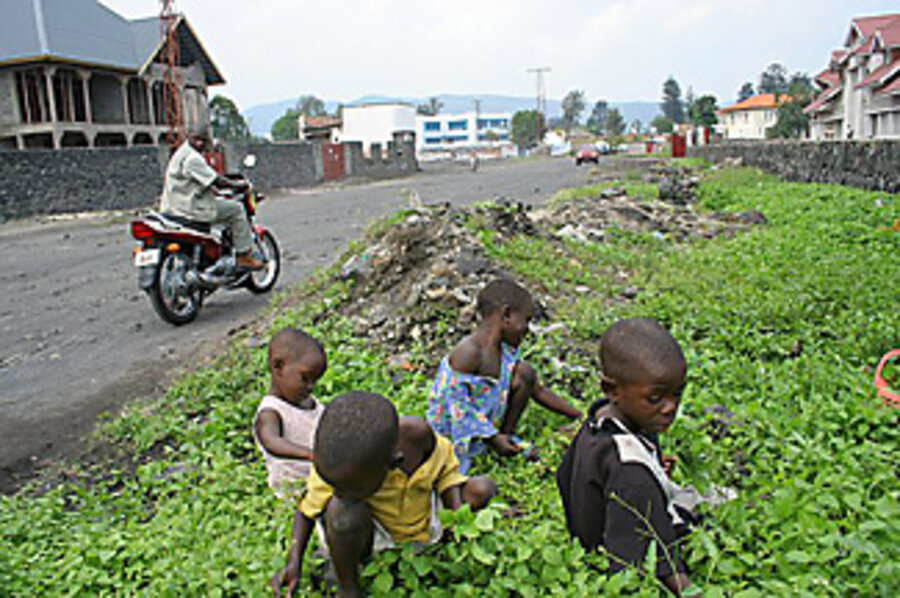Bush's peace opportunity in Congo
Loading...
| Nairobi, Kenya
As President Bush wraps up his choreographed trip to Africa highlighting success stories, it's time to jump on the opportunity to build on recent progress toward ending one of the bloodiest conflicts of the last half century: the crisis in the Democratic Republic of Congo. Not only does Mr. Bush stand to gain a positive legacy in one of the most devastated corners of the world, but the United States can help the people of Congo shake off their decade-long nightmare.
As a report by the International Rescue Committee reminded us last month, some 5.4 million people have died, so far, in the conflict since 1998, mostly due to the humanitarian catastrophe engendered by the violence. Despite a peace deal signed in 2002 and relatively fair elections held in 2006, preventable death continues at the same pace – a staggering 45,000 people die each month, half of whom are children.
Now, finally, some good news: On Jan. 23, the government signed a peace deal with nine rebel groups in the eastern North Kivu region, where violence in the past year has displaced half a million.
And, for the first time in almost a decade, the US has put some diplomatic muscle to work to help find a solution. Tim Shortley, special adviser to assistant secretary of State for Africa, spent two weeks hunkered down in the eastern Congo, shuttling between rebel and government delegations just prior to the signing. Senior diplomats for the European Union and Belgium canceled appointments and followed suit in order to nail a final deal.
As Mr. Shortley has demonstrated, progress is possible if the US government does the meat and potatoes of conflict resolution – patient, firm engagement with all parties by high-level delegates.
The centerpiece of the peace deal is a cease-fire between the government and rebels led by dissident Gen. Laurent Nkunda. Last November, violence intensified dramatically between the two sides, when President Joseph Kabila launched the largest offensive of his seven-year tenure. At least eight local militias helped the 20,000 Congolese troops fight General Nkunda's superior forces. The offensive ended in fiasco as troops from both sides raped, looted, and killed in the process.
The Bush administration and Congress must quickly follow through on the cease-fire by maintaining a large diplomatic presence on the ground and keeping up high-level pressure on all parties. They should also make sure there is funding for reintegrating the thousands of soldiers who could eventually leave the bush – the World Bank has frozen their demobilization program due to administrative problems.
For the deal to accomplish more than just a lull in fighting, the rebels need to disarm and integrate into the national army. It is clear, however, that Nkunda, who presents himself as the protector of the minority Tutsi community, will not go without securing a few things for himself.
As per the deal, his demands are supposed to be hammered out in a technical commission in which all sides are represented. They'll need a big hammer. Getting rid of the FDLR is the linchpin to enduring peace, but the militia – some 6,000 strong – have defied disarmament since 1996. Fortunately (thanks again to the efforts of the State Department working with the United Nations) the governments of Congo and Rwanda signed an agreement in November on how to dismantle the rebels. Significant hurdles remain including Rwanda's refusal to negotiate with the FDLR, most of whom it considers to be guilty of genocide.
The US needs to help cut the Gordian knot that the FDLR has become; this will mean providing military support to the Congolese army, pressure on Rwanda to be as accommodating as possible with commanders not involved in the genocide, and pressure on the Congo to punish officials and businessmen who collaborate or trade with the militia.
Recent steps toward lasting peace in the Congo are a taste of what can be achieved when the international community puts its mind to it, and the Bush administration deserves credit. But this is just the beginning; most of the heavy lifting has yet to be done. The US government has to quickly build on the momentum created and throw its financial, military, and diplomatic weight behind the process before it fizzles out and any progress with the Congo backslides, along with the opportunity to regain some international credibility.
• Jason Stearns, an independent Africa analyst, is writing a book about the Congo war. Colin Thomas-Jensen is policy adviser to The ENOUGH Project, an organization working to end crimes against humanity. They traveled together in eastern Congo last year.





